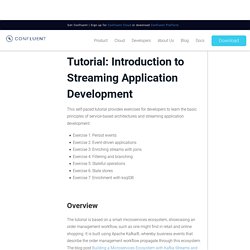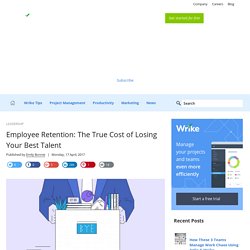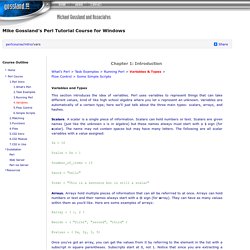

Tutorial: Introduction to Streaming Application Development — Confluent Platform 5.5.1. This self-paced tutorial provides exercises for developers to learn the basic principles of service-based architectures and streaming application development: Overview¶ The tutorial is based on a small microservices ecosystem, showcasing an order management workflow, such as one might find in retail and online shopping.

It is built using Apache Kafka®, whereby business events that describe the order management workflow propagate through this ecosystem. The blog post Building a Microservices Ecosystem with Kafka Streams and ksqlDB outlines the approach used. Note: this is demo code, not a production system, and certain elements are left for further work. Microservices¶ In this example, the system centers on an Orders Service which exposes a REST interface to POST and GET Orders.
The results of the various validation checks are aggregated in the Validation Aggregator Service, which then moves the order to a Validated or Failed state, based on the combined result. End-to-end Streaming ETL¶ Original. Employee Retention: The True Cost of Losing Your Best Talent. How do you spot a great manager?

It’s someone who fosters a culture of productivity and excellence. Someone who’s fun to work with, and connects with their teammates on a personal level. Someone who knows how to inspire and lead their team to success. In short, someone who makes people want to show up — and stay. Low turnover on your team may make you feel like a successful manager. But what if that high employee retention rate is actually a negative—an indication that you’re failing to challenge employees and creating a culture of complacency? What if the few people you’re losing are actually your best and brightest? Employee turnover already costs US companies $160 billion a year. Replacing an employee can set your company back as much as 2x their annual salary. Not only do high-performers cost more to replace, new research by SAP and Oxford Economics shows that less than half of them are satisfied with their jobs, and 1 in 5 say they’re likely to leave in the next six months.
A Cloud Guru - AWS Certification Courses. Amazon Web Services (AWS) Certification is fast becoming the must have certificates for any IT professional working with AWS.

This course is designed to help you pass the AWS Certified Solutions Architect (CSA) - Associate Exam. Even if you have never logged in to the AWS platform before, by the end of our AWS training you will be able to take the CSA exam. No programming knowledge needed and no prior AWS experience required. With this AWS certification under your belt (and optionally after completing our AWS Certified Developer course), you will be in high demand by many employers and you can command a superior salary. In this course we will start with a broad over view of the AWS platform and then deep dive in to the individual elements of the AWS platform.
AWS are constantly evolving their platform, in 2014 there have been over 500 new product releases. Most lectures are 5 - 12 minutes long, with almost no lecture being over 20 minutes in length. Perl Tutorial Course. Chapter 1: Introduction What's Perl > Task Examples > Running Perl > Variables & Types > Flow Control > Some Simple Scripts Variables and Types This section introduces the idea of variables.

Perl uses variables to represent things that can take different values, kind of like high school algebra where you let x represent an unknown. Variables are automatically of a certain type; here we'll just talk about the three main types: scalars, arrays, and hashes. Scalars. $x = 10 $value = $x + 1 $number_of_items = 15 $word = "hello" $text = "This is a sentence but is still a scalar" Arrays. @array = ( 1, 2 ) @words = ( "first", "second", "third" ) @values = ( $x, $y, 3, 5) Once you've got an array, you can get the values from it by referring to the element in the list with a subscript in square parentheses.
$array[0] has the value 1 $array[1] has the value 2 $words[0] has the value "first" and so on. ($x, $y, $z ) = ( 1, 2, 3); would assign the values 1, 2, 3 to $x, $y, $z respectively. Hashes. Print; One Month. Got questions?

We've got answers. Is this a one-time payment or monthly subscription? It's a monthly subscription, but don't worry: commitment freaks us out, too. There are no contracts and no hidden fees. You'll be charged once a month, and can cancel whenever you want. How long do I have access to the course for? You have access as long as you're enrolled. What if I need more time? Our classes are designed to be completed in one month, but our students sometimes want to do it all in one weekend, or take longer and pace it out over a few months. Kanban Learning Center - LeanKit.